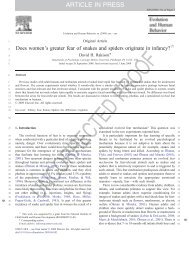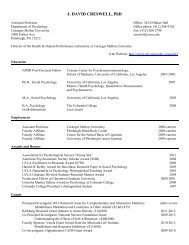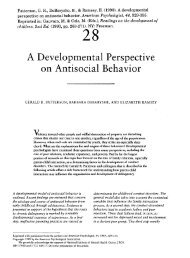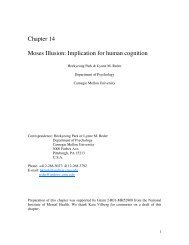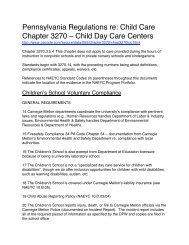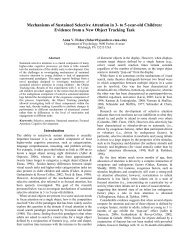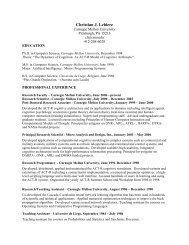Prenatal and Postnatal Maternal Stress and Wheeze in Urban ...
Prenatal and Postnatal Maternal Stress and Wheeze in Urban ...
Prenatal and Postnatal Maternal Stress and Wheeze in Urban ...
You also want an ePaper? Increase the reach of your titles
YUMPU automatically turns print PDFs into web optimized ePapers that Google loves.
<strong>Prenatal</strong> <strong>and</strong> <strong>Postnatal</strong> <strong>Maternal</strong> <strong>Stress</strong> <strong>and</strong> <strong>Wheeze</strong><br />
<strong>in</strong> <strong>Urban</strong> Children<br />
Effect of <strong>Maternal</strong> Sensitization<br />
Yueh-Hsiu Mathilda Chiu 1 , Brent A. Coull 1,2 , Sheldon Cohen 3 , Alana Wooley 4 ,<br />
<strong>and</strong> Rosal<strong>in</strong>d J. Wright 1,5<br />
1 Department of Environmental Health <strong>and</strong> 2 Department of Biostatistics, Harvard School of Public Health, Boston, Massachusetts; 3 Department of<br />
Psychology, Carnegie Mellon University, Pittsburgh, Pennsylvania; 4 Department of Health Behavior <strong>and</strong> Health Education, University of Michigan<br />
School of Public Health, Ann Arbor, Michigan; <strong>and</strong> 5 Chann<strong>in</strong>g Laboratory, Brigham <strong>and</strong> Women’s Hospital <strong>and</strong> Harvard Medical School, Boston,<br />
Massachusetts<br />
Rationale: Critical periods for programm<strong>in</strong>g early wheeze risk may<br />
<strong>in</strong>clude pregnancy <strong>and</strong> <strong>in</strong>fancy. Effects of tim<strong>in</strong>g rema<strong>in</strong> poorly understood.<br />
Objectives: Associations among prenatal <strong>and</strong> postnatal maternal<br />
stress <strong>and</strong> children’s wheeze were prospectively exam<strong>in</strong>ed <strong>in</strong> 653<br />
families. Effect modification by maternal sensitization was also exam<strong>in</strong>ed.<br />
Methods: <strong>Stress</strong> was <strong>in</strong>dexed by a maternal negative life events<br />
(NLEs) score (range, 0–9) ascerta<strong>in</strong>ed dur<strong>in</strong>g pregnancy <strong>and</strong> between<br />
1 <strong>and</strong> 2 years postpartum. Mothers reported child wheeze<br />
every 3 months up to age 2 years. Relationships of prenatal <strong>and</strong><br />
postnatal maternal NLEs with repeated wheeze (>2 episodes) were<br />
exam<strong>in</strong>ed us<strong>in</strong>g logistic regression adjust<strong>in</strong>g for covariates. Penalized<br />
spl<strong>in</strong>es were implemented to explore possible nonl<strong>in</strong>ear associations.<br />
We also exam<strong>in</strong>ed the <strong>in</strong>teraction between prenatal stress<br />
<strong>and</strong> maternal sensitization <strong>in</strong>dexed by allergen-specific IgE from<br />
maternal prenatal serum.<br />
Measurements <strong>and</strong> Ma<strong>in</strong> Results: Adjusted models consider<strong>in</strong>g prenatal<br />
or postnatal NLEs alone both showed an exposure-response<br />
relationship between higher stress <strong>and</strong> child wheeze. When consider<strong>in</strong>g<br />
prenatal <strong>and</strong> postnatal stress concurrently, only children of<br />
mothers with high stress <strong>in</strong> both periods were significantly more<br />
likely to wheeze (adjusted odds ratio, 3.04; 95% confidence <strong>in</strong>terval,<br />
1.67–5.53) than children of mothers report<strong>in</strong>g low stress <strong>in</strong> both<br />
periods. Associations between high prenatal stress <strong>and</strong> wheeze<br />
were significant <strong>in</strong> children born to nonsensitized mothers (any<br />
IgE ,0.35 kU/L) but not <strong>in</strong> the sensitized group (P for <strong>in</strong>teraction ¼<br />
0.03).<br />
Conclusions: Although children have heightened sensitivity to maternal<br />
stress <strong>in</strong> utero <strong>and</strong> <strong>in</strong> early childhood, those with higher stress<br />
<strong>in</strong> both periods were particularly at risk for wheeze. The prenatal<br />
maternal immune milieu modified effects.<br />
Keywords: negative life events; stress; pregnancy; maternal sensitization;<br />
childhood wheeze<br />
(Received <strong>in</strong> orig<strong>in</strong>al form January 30, 2012; accepted <strong>in</strong> f<strong>in</strong>al form April 26, 2012)<br />
Supported by grants R01 ES10932, U01 HL072494, <strong>and</strong> R01 HL080674 (R.J.W.);<br />
biostatistical support (B.A.C.) was funded by ES000002.<br />
Author Contributions: Y-H.M.C. planned <strong>and</strong> conducted statistical analysis, participated<br />
<strong>in</strong> the <strong>in</strong>terpretation of results, <strong>and</strong> took the lead on writ<strong>in</strong>g the manuscript;<br />
B.A.C. provided statistical expertise <strong>and</strong> contributed to revision of the<br />
manuscript; S.C. <strong>and</strong> A.W. participated <strong>in</strong> data <strong>in</strong>terpretation <strong>and</strong> revision of the<br />
manuscript; <strong>and</strong> R.J.W. contributed project conception, design, supervis<strong>in</strong>g analyses,<br />
data <strong>in</strong>terpretation, <strong>and</strong> writ<strong>in</strong>g of the manuscript.<br />
Correspondence <strong>and</strong> requests for repr<strong>in</strong>ts should be addressed to Rosal<strong>in</strong>d<br />
J. Wright, M.D., M.P.H., Chann<strong>in</strong>g Laboratory, 181 Longwood Avenue, Boston,<br />
MA 02115. E-mail: rerjw@chann<strong>in</strong>g.harvard.edu<br />
This article has an onl<strong>in</strong>e supplement, which is accessible from this issue’s table of<br />
contents at www.atsjournals.org<br />
Am J Respir Crit Care Med Vol 186, Iss. 2, pp 147–154, Jul 15, 2012<br />
Copyright ª 2012 by the American Thoracic Society<br />
Orig<strong>in</strong>ally Published <strong>in</strong> Press as DOI: 10.1164/rccm.201201-0162OC on May 10, 2012<br />
Internet address: www.atsjournals.org<br />
AT A GLANCE COMMENTARY<br />
Scientific Knowledge on the Subject<br />
The <strong>in</strong>fluence of stress on respiratory health likely starts <strong>in</strong><br />
early development. Although critical periods for stressrelated<br />
programm<strong>in</strong>g of early childhood wheeze might<br />
<strong>in</strong>clude pregnancy <strong>and</strong> <strong>in</strong>fancy, the effect of tim<strong>in</strong>g of<br />
exposure rema<strong>in</strong>s poorly understood.<br />
What This Study Adds to the Field<br />
These f<strong>in</strong>d<strong>in</strong>gs suggest that although prenatal <strong>and</strong> postnatal<br />
maternal stress are <strong>in</strong>dependently associated with<br />
<strong>in</strong>creased repeated wheeze <strong>in</strong> urban children, children born<br />
to mothers experienc<strong>in</strong>g higher stress <strong>in</strong> both developmental<br />
periods were particularly at risk for wheeze. The<br />
maternal immune milieu assessed <strong>in</strong> pregnancy modified the<br />
association between prenatal maternal stress <strong>and</strong> childhood<br />
repeated wheeze.<br />
Childhood wheez<strong>in</strong>g illnesses account for significant morbidity<br />
<strong>and</strong> health care use (1). Recurrent wheeze may be a precedent<br />
of asthma <strong>and</strong> reduced lung function (2). An important step <strong>in</strong><br />
identify<strong>in</strong>g children at risk for costly respiratory disorders is<br />
characteriz<strong>in</strong>g risk factors <strong>and</strong> mechanisms that lead to <strong>and</strong><br />
ma<strong>in</strong>ta<strong>in</strong> early predisposition.<br />
Although the spectrum of wheeze phenotypes is complex<br />
<strong>and</strong> mechanisms of early environmental <strong>in</strong>fluences are <strong>in</strong>completely<br />
understood (3, 4), aberrant pro<strong>in</strong>flammatory states are<br />
central determ<strong>in</strong>ants (5, 6). Glucocorticoid action <strong>and</strong> sympathovagal<br />
balance are important <strong>in</strong> regulat<strong>in</strong>g immune function<br />
<strong>and</strong> airway response <strong>in</strong> early development (7, 8). Thus, environmental<br />
factors, such as psychosocial stressors, that <strong>in</strong>fluence<br />
the programm<strong>in</strong>g of regulatory systems <strong>in</strong>volved <strong>in</strong> these processes<br />
(i.e., hypothalamic-pituitary-adrenal [HPA] axis, autonomic<br />
nervous system, immune function) may be particularly<br />
relevant.<br />
Evidence l<strong>in</strong>ks psychosocial stress to wheeze, asthma, <strong>and</strong> airway<br />
hyperesponsiveness (9). Animal studies suggest effects beg<strong>in</strong><br />
prenatally. <strong>Prenatal</strong> stress <strong>in</strong>creases allergen-<strong>in</strong>duced airway<br />
<strong>in</strong>flammation (10, 11) <strong>and</strong> airway hyperesponsiveness (12) <strong>in</strong><br />
mice offspr<strong>in</strong>g <strong>and</strong> impacts the newborn’s antigen response <strong>in</strong><br />
primates (13). Although no prospective human study has measured<br />
prenatal maternal stress directly <strong>in</strong> association with<br />
wheeze or other early asthma phenotypes <strong>in</strong> children, three<br />
have considered maternal psychologic function<strong>in</strong>g as a correlate<br />
of stress exposure. A study <strong>in</strong> Ch<strong>in</strong>a (n ¼ 334) found that
148 AMERICAN JOURNAL OF RESPIRATORY AND CRITICAL CARE MEDICINE VOL 186 2012<br />
<strong>in</strong>creased prenatal maternal nervousness predicted elevated cord<br />
blood IgE adjust<strong>in</strong>g for family history, maternal age, education,<br />
<strong>and</strong> prenatal smok<strong>in</strong>g (14). An Australian study (n ¼ 5,810)<br />
l<strong>in</strong>ked higher prenatal anxiety to <strong>in</strong>creased asthma with airway<br />
hyperesponsiveness <strong>in</strong> school-aged children adjust<strong>in</strong>g for sex,<br />
prematurity, maternal age, education, atopy, prenatal smok<strong>in</strong>g,<br />
<strong>and</strong> postnatal maternal anxiety (15). Reyes <strong>and</strong> colleagues<br />
(16) reported an association between a composite measure of<br />
prenatal psychologic function<strong>in</strong>g (maternal demoralization)<br />
<strong>and</strong> <strong>in</strong>creased risk of wheeze <strong>in</strong> an urban New York sample<br />
adjust<strong>in</strong>g for maternal (age, ethnicity, education, asthma, IgE)<br />
<strong>and</strong> child (sex, tobacco smoke exposure) factors. <strong>Postnatal</strong><br />
stress may also play a role. For example, greater caregiverperceived<br />
stress <strong>in</strong> <strong>in</strong>fancy has been prospectively associated<br />
with repeated wheeze <strong>in</strong> children (17). Although critical periods<br />
for stress-related programm<strong>in</strong>g of wheeze may <strong>in</strong>clude<br />
pregnancy <strong>and</strong> early childhood, the <strong>in</strong>fluence of tim<strong>in</strong>g of exposure<br />
is not well understood.<br />
<strong>Prenatal</strong> stress may <strong>in</strong>fluence <strong>in</strong>fant respiratory disease<br />
through transplacental passage of maternal hormones <strong>and</strong> other<br />
metabolic cues <strong>and</strong> by impact<strong>in</strong>g maternal–fetal immune <strong>in</strong>teractions<br />
(18). Children born to allergic mothers are exposed to<br />
a unique prenatal biologic environment compared with those of<br />
nonallergic mothers (19). Thus, it is possible that prenatal stress<br />
effects may differ based on maternal sensitization.<br />
We exam<strong>in</strong>ed whether higher maternal stress, assessed <strong>in</strong><br />
pregnancy <strong>and</strong> postnatally, was associated with <strong>in</strong>creased repeated<br />
childhood wheeze tak<strong>in</strong>g <strong>in</strong>to account tim<strong>in</strong>g of exposure.<br />
Specifically, we exam<strong>in</strong>ed whether higher stress <strong>in</strong> early developmental<br />
periods was significantly associated with children’s<br />
repeated wheeze, consider<strong>in</strong>g prenatal or postnatal stress alone<br />
<strong>and</strong> stress persist<strong>in</strong>g over both sensitive periods. We also exam<strong>in</strong>ed<br />
whether prenatal stress effects differed relative to maternal<br />
sensitization <strong>in</strong>dexed by specific IgE to common aeroallergens<br />
assessed <strong>in</strong> pregnancy. Some of the results of these analyses<br />
were presented at the 2012 American Thoracic Society International<br />
Conference (20).<br />
METHODS<br />
Study Participants<br />
Between August 2002 <strong>and</strong> September 2009, English- or Spanishspeak<strong>in</strong>g<br />
women receiv<strong>in</strong>g prenatal care at two Boston hospitals<br />
<strong>and</strong> affiliated community health centers were recruited <strong>in</strong>to the<br />
Asthma Coalition on Community, Environment, <strong>and</strong> Social <strong>Stress</strong> project,<br />
a pregnancy cohort exam<strong>in</strong><strong>in</strong>g the effects of per<strong>in</strong>atal stress <strong>and</strong><br />
other environmental factors on urban childhood asthma risk (21).<br />
Among women approached <strong>in</strong> mid-to-late pregnancy (28.4 6 7.9<br />
wk gestation) who were eligible, 989 (78.1%) agreed to enroll. Based<br />
on screen<strong>in</strong>g data, there were no significant differences for race <strong>and</strong><br />
ethnicity, education, <strong>and</strong> <strong>in</strong>come between participants who enrolled<br />
<strong>and</strong> those who decl<strong>in</strong>ed. Of those enrolled, 955 gave birth to a liveborn<br />
<strong>in</strong>fant <strong>and</strong> cont<strong>in</strong>ued follow-up. This study <strong>in</strong>cluded a subset of<br />
653 mother–child pairs with two or more postnatal <strong>in</strong>terviews<br />
followed-up to age 2 years <strong>and</strong> data on prenatal <strong>and</strong> postnatal stress.<br />
Procedures were approved by human studies committees at the Brigham<br />
<strong>and</strong> Women’s Hospital <strong>and</strong> Boston Medical Center <strong>and</strong> written<br />
consent was obta<strong>in</strong>ed.<br />
Negative Life Events<br />
<strong>Prenatal</strong> <strong>and</strong> postnatal maternal stress were respectively measured<br />
with<strong>in</strong> 2 weeks of enrollment <strong>and</strong> between 12 <strong>and</strong> 18 months postnatally<br />
us<strong>in</strong>g the Crisis <strong>in</strong> Family Systems-Revised survey, validated <strong>in</strong><br />
English <strong>and</strong> Spanish (22, 23). The survey assesses life events experienced<br />
across 11 doma<strong>in</strong>s (e.g., f<strong>in</strong>ancial, relationships, violence, other<br />
hous<strong>in</strong>g issues, <strong>and</strong> discrim<strong>in</strong>ation <strong>and</strong> prejudice). Mothers endorsed<br />
events experienced <strong>in</strong> the past 6 months <strong>and</strong> rated each as positive,<br />
negative, or neutral. Because research suggests <strong>in</strong>creased vulnerability<br />
when experienc<strong>in</strong>g events across multiple doma<strong>in</strong>s (24), the number<br />
of doma<strong>in</strong>s with one or more negative event was summed to<br />
create a negative life events (NLEs) doma<strong>in</strong> score, with higher scores<br />
<strong>in</strong>dicat<strong>in</strong>g greater stress. Although the survey <strong>in</strong>quires about events<br />
across 11 doma<strong>in</strong>s, participants <strong>in</strong> this study reported experienc<strong>in</strong>g<br />
events <strong>in</strong> none to a maximum of n<strong>in</strong>e doma<strong>in</strong>s.<br />
Repeated <strong>Wheeze</strong><br />
<strong>Maternal</strong>-reported child wheeze was ascerta<strong>in</strong>ed from birth to age 2<br />
years through telephone <strong>and</strong> face-to-face <strong>in</strong>terviews at approximately<br />
3-month <strong>in</strong>tervals. Mothers were asked, “S<strong>in</strong>ce we last spoke with<br />
you on (date), has your <strong>in</strong>fant/child had wheez<strong>in</strong>g or whistl<strong>in</strong>g <strong>in</strong> the<br />
chest?” Repeated wheeze was def<strong>in</strong>ed as greater than or equal to two<br />
episodes (3). Of the 653 children, 414 (63.4%) never wheezed; 159<br />
(24.4%) wheezed once; <strong>and</strong> 45 (6.9%), 24 (3.7%), 9 (1.4%), <strong>and</strong> 2<br />
(0.3%) had two, three, four, <strong>and</strong> five wheeze episodes, respectively.<br />
Covariates<br />
Potential confounders, pathway variables, <strong>and</strong> modify<strong>in</strong>g variables were<br />
considered. <strong>Maternal</strong> age, race <strong>and</strong> ethnicity, education, atopic history<br />
(ever hav<strong>in</strong>g cl<strong>in</strong>ician-diagnosed asthma, eczema, or hay fever), <strong>and</strong> prepregnancy<br />
height <strong>and</strong> weight <strong>and</strong> child’s sex, season of birth, <strong>and</strong> birthweight<br />
were ascerta<strong>in</strong>ed by questionnaire. <strong>Maternal</strong> body mass <strong>in</strong>dex<br />
(BMI) was calculated as weight divided by height squared (kilogram<br />
per square meter). Mothers reported smok<strong>in</strong>g at basel<strong>in</strong>e <strong>and</strong> <strong>in</strong> the<br />
third trimester; women were classified as prenatal smokers if smok<strong>in</strong>g<br />
at either visit. <strong>Postnatal</strong> smok<strong>in</strong>g was reported at each 3-month postpartum<br />
<strong>in</strong>terview.<br />
<strong>Prenatal</strong> exposure to traffic-related air pollution, specifically black<br />
carbon (BC), was estimated based on resident address (updated if<br />
participants moved) over the entire pregnancy us<strong>in</strong>g a previously<br />
described validated spatiotemporal l<strong>and</strong> use regression model (25).<br />
Childrens’ postnatal exposure from birth to 2 years was similarly<br />
estimated.<br />
Settled dust collected with<strong>in</strong> 2 weeks of enrollment from the mother’s<br />
bedroom us<strong>in</strong>g a st<strong>and</strong>ardized protocol (26) was assayed for cockroach<br />
allergen (Blatella germanica, [Bla g 1 <strong>and</strong> 2]) us<strong>in</strong>g a monoclonal<br />
antibody-based ELISA (Indoor Biotechnologies, Charlottesville, VA).<br />
High exposure was def<strong>in</strong>ed as Bla g 1 or 2 greater than 2 U/g.<br />
A measure of neighborhood disadvantage was derived by l<strong>in</strong>k<strong>in</strong>g<br />
enrollment addresses with aggregated data (census tract) from the<br />
2000 US Census <strong>in</strong>dexed as an average z score for percentages of<br />
residents liv<strong>in</strong>g below poverty, the unemployed, non-US citizens,<br />
<strong>and</strong> nonwhite <strong>in</strong> the neighborhood (27). Z scores are <strong>in</strong>terpreted<br />
<strong>in</strong> a relative sense; neighborhoods with the most positive scores<br />
are most disadvantaged <strong>and</strong> those at the most negative end are least<br />
disadvantaged.<br />
Mother’s serum collected <strong>in</strong> the second or third trimester was analyzed<br />
for specific IgE us<strong>in</strong>g CAP fluorescent enzyme immunoassay<br />
(Pharmacia [now Phadia], Uppsala, Sweden). Sensitization was def<strong>in</strong>ed<br />
as hav<strong>in</strong>g a specific IgE greater than or equal to 0.35 kU/L to one or<br />
more common aeroallergens: Dermatophagoides pteronyss<strong>in</strong>us 1, Bla g<br />
1 or 2, Canis familiaris 1, Felis domesticus 1, ragweed, rye grass, Aspergillus<br />
fumigatus, orAlternaria alternata.<br />
Analysis<br />
When compar<strong>in</strong>g those enrolled, those <strong>in</strong>cluded <strong>in</strong> the analyses, <strong>and</strong><br />
those excluded, the distributions were similar across covariates (see<br />
Table E1 <strong>in</strong> the onl<strong>in</strong>e supplement). Characteristics of the 653<br />
mother–child pairs <strong>in</strong>cluded <strong>in</strong> analyses are summarized <strong>in</strong> Table 1.<br />
Sensitization data were available on 401 pairs <strong>and</strong> the distributions<br />
were similar across covariates between subjects <strong>in</strong>cluded <strong>in</strong> analyses<br />
with <strong>and</strong> without IgE (Table 1). Miss<strong>in</strong>gness on covariates was approximately<br />
5% or less, thus the miss<strong>in</strong>g <strong>in</strong>dicator method was used <strong>in</strong><br />
analyses.<br />
Spearman correlations between maternal NLEs scores <strong>and</strong> other environmental<br />
factors were low to moderate (Table 2); thus, all were<br />
<strong>in</strong>cluded <strong>in</strong> analyses. <strong>Prenatal</strong> <strong>and</strong> postnatal BC levels were highly<br />
correlated (Spearman r ¼ 0.96; P , 0.001); therefore, analyses
Chiu, Coull, Cohen, et al.: Per<strong>in</strong>atal <strong>Maternal</strong> <strong>Stress</strong> <strong>and</strong> <strong>Wheeze</strong> <strong>in</strong> <strong>Urban</strong> Children 149<br />
considered only prenatal BC. Multivariate logistic regression analyses<br />
first considered associations between the NLEs score <strong>and</strong> child<br />
wheeze <strong>in</strong>clud<strong>in</strong>g prenatal <strong>and</strong> postnatal NLEs <strong>in</strong> separate models<br />
(i.e., <strong>in</strong>dependent effects of stress <strong>in</strong> each respective period). The<br />
NLEs score was categorized apriorias 0, 1–2, 3–4, or greater than<br />
or equal to 5 to assess exposure-response relationships <strong>and</strong> the possibility<br />
of nonl<strong>in</strong>earity. To exam<strong>in</strong>e the effects of the comb<strong>in</strong>ation of<br />
prenatal <strong>and</strong> postnatal NLEs, we next collapsed NLEs scores <strong>in</strong>to low<br />
(0–2, at or below the median) <strong>and</strong> high (>3, above the median)<br />
groups, <strong>and</strong> categorized maternal stress <strong>in</strong>to four comb<strong>in</strong>ations: (1)<br />
low prenatal–low postnatal, (2) high prenatal–low postnatal, (3) low<br />
prenatal–high postnatal, <strong>and</strong> (4) high prenatal–high postnatal stress.<br />
This model exam<strong>in</strong>ed whether stress <strong>in</strong> one developmental period<br />
(prenatal or postnatal) or stress persist<strong>in</strong>g over both sensitive developmental<br />
periods was most significantly associated with child<br />
repeated wheeze, compared with low stress <strong>in</strong> both periods. To ensure<br />
these results were not unduly affected by the choice of NLE<br />
cutpo<strong>in</strong>ts, we also explored the exposure-response relationships consider<strong>in</strong>g<br />
NLEs as cont<strong>in</strong>uous us<strong>in</strong>g generalized additive models<br />
(GAMs) with smooth penalized spl<strong>in</strong>e terms (28) for the NLEs<br />
effects. We did this by fitt<strong>in</strong>g separate GAM models conta<strong>in</strong><strong>in</strong>g<br />
a smooth term for a s<strong>in</strong>gle NLEs score for each developmental period,<br />
<strong>and</strong> a GAM model that assessed the jo<strong>in</strong>t effects of prenatal <strong>and</strong><br />
postnatal NLEs us<strong>in</strong>g a bivariate spl<strong>in</strong>e (i.e., two-dimensional<br />
smooth) term.<br />
Infant sex <strong>and</strong> season of birth were entered as st<strong>and</strong>ard controls. We<br />
then considered covariates l<strong>in</strong>ked to stress <strong>and</strong> wheeze <strong>in</strong> previous research.<br />
<strong>Maternal</strong> age, race, educational status, <strong>and</strong> self-reported atopy<br />
were considered as confounders. To further account for neighborhoodlevel<br />
physical or social environmental determ<strong>in</strong>ants that may confound<br />
the relationship between <strong>in</strong>dividual-level stress <strong>and</strong> child wheeze,<br />
traffic-related air pollution, household cockroach exposures, <strong>and</strong> the<br />
neighborhood disadvantage <strong>in</strong>dex were also controlled. Variables that<br />
may be <strong>in</strong> the pathway between prenatal maternal stress <strong>and</strong> offspr<strong>in</strong>g<br />
wheeze, <strong>in</strong>clud<strong>in</strong>g prepregnancy BMI, prenatal <strong>and</strong> postnatal smok<strong>in</strong>g,<br />
<strong>and</strong> child’s birthweight adjust<strong>in</strong>g for gestational age (29), were also considered.<br />
Effect modification by maternal sensitization was exam<strong>in</strong>ed<br />
us<strong>in</strong>g stratified analysis <strong>and</strong> by fitt<strong>in</strong>g <strong>in</strong>teraction terms among those<br />
401 mother–child pairs with IgE measurements. Most analyses were<br />
performed us<strong>in</strong>g SAS (version 9.1.3, SAS Institute, Inc., Cary, NC);<br />
GAMs were implemented <strong>in</strong> the mgcv package <strong>in</strong> R (version 2.13.0,<br />
The R Foundation for Statistical Comput<strong>in</strong>g, Vienna, Austria).<br />
TABLE 1. ASTHMA COALITION ON COMMUNITY, ENVIRONMENT, AND SOCIAL STRESS<br />
PARTICIPANT CHARACTERISTICS<br />
All Participants (n ¼ 653) With IgE Data (n ¼ 401)<br />
n % n %<br />
Categorical variables<br />
Repeated wheeze until age 2 yr*<br />
No 573 87.8 354 88.3<br />
Yes<br />
Child’s sex<br />
80 12.3 47 11.7<br />
Female 318 48.7 207 51.6<br />
Male<br />
Race<br />
335 51.3 194 48.4<br />
Hispanic 356 54.5 248 61.9<br />
Black 189 28.9 100 24.9<br />
White/other 97 14.9 53 13.2<br />
Miss<strong>in</strong>g<br />
Season of birth<br />
11 1.7 0 0<br />
W<strong>in</strong>ter 172 26.3 112 27.9<br />
Spr<strong>in</strong>g 148 22.7 89 22.2<br />
Summer 141 21.6 82 20.5<br />
Fall<br />
<strong>Maternal</strong> education<br />
192 29.4 118 29.4<br />
.12 yr 214 32.8 118 29.4<br />
2 episodes).<br />
y Ever self-reported doctor-diagnosed asthma, eczema, or hay fever.<br />
z Assessed us<strong>in</strong>g Crisis <strong>in</strong> Family Systems-Revised survey; multiitem survey summarized <strong>in</strong>to a cont<strong>in</strong>uous score.
150 AMERICAN JOURNAL OF RESPIRATORY AND CRITICAL CARE MEDICINE VOL 186 2012<br />
TABLE 2. SPEARMAN CORRELATIONS BETWEEN PRENATAL AND POSTNATAL STRESS AND PHYSICAL ENVIRONMENTAL EXPOSURES<br />
RESULTS<br />
<strong>Prenatal</strong><br />
NLEs<br />
<strong>Postnatal</strong><br />
NLEs<br />
Mothers were primarily ethnic m<strong>in</strong>ority (55% Hispanic, 29% African<br />
American), low socioeconomic status (62% hav<strong>in</strong>g 3) relative<br />
to lower stress (NLEs 0–2) <strong>and</strong> repeated wheeze <strong>in</strong> children<br />
born to mothers without a positive specific IgE level (adjusted<br />
OR, 2.35; 95% CI, 1.04–5.29) but not <strong>in</strong> the sensitized group<br />
(adjusted OR, 0.27; 95% CI, 0.07–1.08) (P for <strong>in</strong>teraction ¼<br />
0.03).<br />
TABLE 3. MULTIVARIABLE LOGISTIC REGRESSION MODELS EXAMINING MATERNAL NLES IN RELATION TO REPEATED WHEEZE IN URBAN<br />
CHILDREN AT AGE 2 YEARS<br />
Multivariable-adjusted Models*<br />
NLEs Doma<strong>in</strong> Score<br />
No. with Repeated<br />
Univariate Model Model 1 Model 2 Model 3<br />
(range 0–9) n <strong>Wheeze</strong> (%) OR 95% CI OR 95% CI OR 95% CI OR 95% CI<br />
<strong>Prenatal</strong> NLEs Model<br />
0 117 6 (5.1%) Ref — — Ref — — Ref — — Ref — —<br />
1–2 261 25 (9.5%) 1.96 0.78 4.91 2.04 0.81 5.14 1.95 0.77 4.97 1.95 0.76 5.00<br />
3–4 171 30 (17.5%) 3.93 1.58 9.78 4.06 1.62 10.2 3.77 1.48 9.63 3.55 1.38 9.15<br />
>5 104 19 (18.3%) 4.13 1.58 10.8 4.34 1.64 11.4 4.03 1.50 10.8 3.79 1.39 10.3<br />
<strong>Postnatal</strong> NLEs Model<br />
0 127 10 (7.9%) Ref — — Ref — — Ref — — Ref — —<br />
1–2 274 23 (8.4%) 1.07 0.49 2.33 1.07 0.49 2.34 1.00 0.45 2.19 0.96 0.43 2.15<br />
3–4 159 24 (15.1%) 2.08 0.96 4.53 2.18 0.97 4.63 1.99 0.90 4.41 1.88 0.83 4.26<br />
>5 93 23 (28.8%) 3.85 1.73 8.55 3.93 1.75 8.82 3.66 1.60 8.35 3.35 1.42 7.86<br />
Def<strong>in</strong>ition of abbreviations: CI¼ confidence <strong>in</strong>terval; NLE ¼ negative life events; OR ¼ odds ratio.<br />
Model 1 <strong>in</strong>cluded st<strong>and</strong>ard control variables (child’s sex, season of birth).<br />
Model 2 additionally <strong>in</strong>cluded demographic variables (race/ethnicity, education, <strong>and</strong> self-reported maternal history of atopy).<br />
Model 3 additionally <strong>in</strong>cluded other physical <strong>and</strong> social environmental exposures (prenatal traffic-related air pollution [black carbon], household cockroach allergen,<br />
neighborhood disadvantage <strong>in</strong>dex).<br />
* Multivariable-adjusted logistic regressions (Models 1–3) predict<strong>in</strong>g repeated wheeze (dependent variable).
Chiu, Coull, Cohen, et al.: Per<strong>in</strong>atal <strong>Maternal</strong> <strong>Stress</strong> <strong>and</strong> <strong>Wheeze</strong> <strong>in</strong> <strong>Urban</strong> Children 151<br />
DISCUSSION<br />
This study adds to the literature <strong>in</strong> three important ways. To our<br />
knowledge, these are the first prospective human data to show<br />
an exposure-response relationship between greater prenatal<br />
<strong>and</strong> postnatal maternal stress, when considered <strong>in</strong>dependently,<br />
<strong>and</strong> <strong>in</strong>creased odds of early childhood repeated wheeze. Moreover,<br />
although children had heightened sensitivity to maternal<br />
stress <strong>in</strong> utero <strong>and</strong> <strong>in</strong> early childhood, those with higher maternal<br />
stress <strong>in</strong> both developmental periods were most likely to<br />
have recurrent wheeze. Also, effects of prenatal stress were<br />
modified based on whether mothers were sensitized to aeroallergens.<br />
Notably, observed effects rema<strong>in</strong>ed significant when<br />
adjust<strong>in</strong>g for a number of important confounders <strong>and</strong> pathway<br />
variables.<br />
Our data <strong>in</strong>dicate that cumulative exposure to greater maternal<br />
stress <strong>in</strong> the prenatal <strong>and</strong> early postnatal period was more<br />
significantly associated with repeated wheeze rather than suggest<strong>in</strong>g<br />
the import of one developmental period over the other.<br />
This is consistent with other evidence suggest<strong>in</strong>g that prenatal<br />
stress <strong>and</strong> psychologic correlates <strong>in</strong> mothers act <strong>in</strong> concert with<br />
postnatal stress-related factors (e.g., disrupted caregiver–child<br />
<strong>in</strong>teractions) to further shape or program offspr<strong>in</strong>g regulatory<br />
systems that may contribute to wheeze expression (9, 30). <strong>Prenatal</strong><br />
stress may disrupt maternal physiology (e.g., HPA axis,<br />
sympathetic-adrenal-medullary system, immunomodulation),<br />
which then may potentiate the develop<strong>in</strong>g fetal immune system<br />
(e.g., up-regulat<strong>in</strong>g maternal <strong>and</strong> fetoplacental Th2 cytok<strong>in</strong>e or<br />
IgE production) (9). We have previously demonstrated that<br />
prenatal stress was associated with disrupted maternal–fetal<br />
HPA axis function<strong>in</strong>g (31, 32) <strong>and</strong> elevated cord blood IgE<br />
(33). <strong>Stress</strong> <strong>in</strong> pregnancy may also <strong>in</strong>fluence fetal programm<strong>in</strong>g<br />
of bra<strong>in</strong> neurotransmitter systems, autonomic nervous system<br />
function<strong>in</strong>g, <strong>and</strong> the HPA axis, which alters the child’s neural<br />
regulation of immune function. Moreover, the <strong>in</strong>fant HPA system<br />
<strong>and</strong> autonomic response cont<strong>in</strong>ue to show developmental<br />
changes postnatally (plasticity) (34, 35). <strong>Maternal</strong> function<strong>in</strong>g<br />
<strong>and</strong> caregiv<strong>in</strong>g dur<strong>in</strong>g early development <strong>in</strong>fluences the emergence<br />
of self-regulation abilities, with sensitive caregiv<strong>in</strong>g associated<br />
with more optimal function<strong>in</strong>g of the child’s stress<br />
response (36). <strong>Postnatal</strong>ly, <strong>in</strong>creased maternal stress has been<br />
associated with impaired parent<strong>in</strong>g behaviors <strong>and</strong> poor child<br />
stress regulation (35, 37). Per<strong>in</strong>atal maternal–child <strong>in</strong>teractions<br />
may disrupt <strong>in</strong>fant emotion regulation <strong>and</strong> neuroimmune development,<br />
sett<strong>in</strong>g the stage for altered immune <strong>and</strong> airway reactivity.<br />
That is, offspr<strong>in</strong>g of mothers who have stress-related<br />
biobehavioral sequelae may <strong>in</strong>herit biologic vulnerability to<br />
Figure 1. Exposure-response relationships<br />
between maternal negative life events<br />
(NLEs) <strong>and</strong> children’s repeated wheeze.<br />
Penalized spl<strong>in</strong>e curves demonstrat<strong>in</strong>g<br />
the relationship of (A) prenatal maternal<br />
NLEs <strong>and</strong> (B) postnatal maternal NLEs <strong>in</strong><br />
separate models with children’s repeated<br />
wheeze by age 2 years are shown. Solid<br />
l<strong>in</strong>e depicts the penalized spl<strong>in</strong>e curve; dotted<br />
l<strong>in</strong>es <strong>in</strong>dicate the 95% confidence<br />
bounds. Models were adjusted for child’s<br />
sex; season of birth; maternal race; maternal<br />
education; maternal atopy; prenatal<br />
traffic-related air pollution (black carbon);<br />
household cockroach allergen; <strong>and</strong> the<br />
neighborhood disadvantage <strong>in</strong>dex.<br />
disrupted stress regulatory systems alter<strong>in</strong>g their reactivity to<br />
postnatal challenges that then further contributes to wheeze<br />
risk. This may expla<strong>in</strong> the more significant effect among children<br />
born to mothers experienc<strong>in</strong>g higher stress across both<br />
developmental periods.<br />
In addition, psychosocial stress might alter mothers’ health<br />
behaviors per<strong>in</strong>atally, such as smok<strong>in</strong>g (38), which may contribute<br />
to early wheeze. <strong>Maternal</strong> stress may contribute to<br />
mothers’ obesity (39) or poor fetal growth (40) (i.e., other<br />
factors l<strong>in</strong>ked to child wheeze) (41, 42). However, adjust<strong>in</strong>g<br />
for maternal BMI, birthweight, <strong>and</strong> maternal smok<strong>in</strong>g did not<br />
affect our f<strong>in</strong>d<strong>in</strong>gs.<br />
Because of potential covariance across exposures <strong>and</strong> evidence<br />
that social stress <strong>and</strong> other environmental tox<strong>in</strong>s (e.g., pollutants,<br />
household allergens) may <strong>in</strong>fluence common physiologic pathways<br />
(e.g., oxidative stress, pro<strong>in</strong>flammatory immune pathways,<br />
Figure 2. Relationships of comb<strong>in</strong>ed levels of prenatal <strong>and</strong> postnatal<br />
maternal stress with children’s repeated wheeze. Odds ratios (ORs)<br />
<strong>and</strong> 95% confidence <strong>in</strong>tervals for repeated wheeze compar<strong>in</strong>g each<br />
comb<strong>in</strong>ation of prenatal–postnatal stress. High stress is <strong>in</strong>dicated by<br />
a negative life events score greater than or equal to 3, <strong>and</strong> low stress<br />
is <strong>in</strong>dicated by a negative life events score of 0–2. Logistic regression<br />
models were adjusted for child’s sex; season of birth; maternal race;<br />
maternal education; maternal prenatal <strong>and</strong> postnatal smok<strong>in</strong>g; maternal<br />
atopy; prenatal traffic-related air pollution (black carbon); household<br />
cockroach allergen; <strong>and</strong> the neighborhood disadvantage <strong>in</strong>dex.
152 AMERICAN JOURNAL OF RESPIRATORY AND CRITICAL CARE MEDICINE VOL 186 2012<br />
Figure 3. Associations between prenatal maternal negative life events<br />
(NLEs) <strong>and</strong> children’s repeated wheeze, stratified by maternal sensitization.<br />
Odds ratios (ORs) <strong>and</strong> 95% confidence <strong>in</strong>tervals for repeated<br />
wheeze compar<strong>in</strong>g high prenatal NLEs (>3) with low prenatal NLEs<br />
(0–2) groups, stratified by maternal sensitization (def<strong>in</strong>ed by any IgE<br />
level >0.35 kU/L). Models were adjusted for child’s sex; season of birth;<br />
maternal race; maternal education; prenatal traffic-related air pollution<br />
(black carbon); household cockroach allergen; <strong>and</strong> the neighborhood<br />
disadvantage <strong>in</strong>dex.<br />
autonomic disruption) contribut<strong>in</strong>g to wheeze, we also considered<br />
these as potential confounders. Be<strong>in</strong>g exposed to higher<br />
stress (more NLEs) was correlated with liv<strong>in</strong>g <strong>in</strong> neighborhoods<br />
with greater disadvantage <strong>and</strong> higher traffic-related air pollution<br />
exposure <strong>in</strong> this urban sample, but not with cockroach exposure.<br />
Even when adjust<strong>in</strong>g for these covariates, effects of stress<br />
rema<strong>in</strong>ed.<br />
In stratified analyses, the association between prenatal maternal<br />
stress <strong>and</strong> child’s repeated wheeze was significant only<br />
among children with nonsensitized mothers. This f<strong>in</strong>d<strong>in</strong>g may<br />
provide <strong>in</strong>sight <strong>in</strong>to potential underly<strong>in</strong>g mechanisms. Children<br />
of sensitized mothers are already exposed to a unique<br />
biologic environment dur<strong>in</strong>g pregnancy, which may be polariz<strong>in</strong>g<br />
the child’s develop<strong>in</strong>g immune system toward aberrant<br />
<strong>in</strong>nate <strong>and</strong> acquired immune responses that may contribute to<br />
wheeze (19). <strong>Stress</strong> may also <strong>in</strong>duce a greater shift toward<br />
Th2-mediated humoral immunity (43). Thus, even though<br />
the pathway through which stress is operat<strong>in</strong>g <strong>in</strong> children of<br />
sensitized mothers is more likely to <strong>in</strong>volve an enhanced Th2<br />
shift <strong>and</strong> <strong>in</strong>creased IgE production, we may not be able to<br />
measure stress effects above what is be<strong>in</strong>g driven by the maternal<br />
immune milieu <strong>in</strong> sensitized women. Alternatively, f<strong>in</strong>d<strong>in</strong>g<br />
a stronger effect among children of women who are not<br />
sensitized may <strong>in</strong>dicate that stress has a greater <strong>in</strong>fluence on<br />
nonatopic wheeze <strong>and</strong> that pathways outside the immune<br />
framework may be operat<strong>in</strong>g (e.g., oxidative stress, autonomic<br />
imbalance). Future research exam<strong>in</strong><strong>in</strong>g the posited pathways<br />
more def<strong>in</strong>itively is needed.<br />
Strengths of this study <strong>in</strong>clude the prospective design; the focus<br />
on the prenatal <strong>and</strong> early postnatal exposure periods, which<br />
are critical to early childhood wheeze; the reasonably large lower<br />
socioeconomic status <strong>and</strong> ethnically mixed <strong>in</strong>ner-city cohort;<br />
available data on many important confounders <strong>and</strong> potential<br />
pathway variables; <strong>and</strong> the use of biomarkers to <strong>in</strong>dex maternal<br />
sensitization <strong>in</strong> pregnancy. This is the first study with repeated<br />
assessments dur<strong>in</strong>g different developmental periods us<strong>in</strong>g a validated<br />
st<strong>and</strong>ardized measure of major life events developed specifically<br />
to comprehensively measure event doma<strong>in</strong>s likely to<br />
be experienced by lower-<strong>in</strong>come, ethnically mixed groups. Although<br />
the prenatal NLEs assessment was before postnatal<br />
wheeze, the temporal relationship between postnatal NLEs<br />
<strong>and</strong> a particular wheez<strong>in</strong>g episode may not be as clear. Given<br />
that the life event questionnaire asks about events occurr<strong>in</strong>g<br />
<strong>in</strong> the past 6 months, it was not possible to determ<strong>in</strong>e when<br />
a given event occurred relative to each wheeze episode. Greater<br />
precision on this temporal relationship would be needed if the<br />
purpose of our study was to <strong>in</strong>vestigate whether NLEs were associated<br />
with one particular wheeze episode (i.e., more acute<br />
effects of stress on subsequent wheez<strong>in</strong>g). In this study we<br />
are ask<strong>in</strong>g a different question, which is whether chronic or cumulative<br />
stress dur<strong>in</strong>g a developmentally sensitive period is related<br />
to higher odds of repeated wheeze, hypothesiz<strong>in</strong>g that<br />
chronic stress <strong>in</strong>fluences underly<strong>in</strong>g pathophysiology that then<br />
contributes to wheeze (e.g, greater maternal stress lead<strong>in</strong>g to<br />
more difficult parent<strong>in</strong>g behaviors that <strong>in</strong>fluence emotion regulation<br />
processes <strong>in</strong> children with consequences for immunomodulation).<br />
We also acknowledge limitations. Although maternal-reported<br />
repeated wheeze is a reasonable surrogate for those who may be<br />
more likely to develop asthma or have compromised lung function<br />
(17), it is important to exam<strong>in</strong>e the relationship between<br />
maternal stress <strong>and</strong> more def<strong>in</strong>itive outcomes as these children<br />
grow (i.e., physician-diagnosed asthma, lung function) <strong>and</strong> see if<br />
relationships still hold. F<strong>in</strong>ally, it is possible that a mother experienc<strong>in</strong>g<br />
higher stress might tend to underreport her child’s<br />
symptoms if overwhelmed <strong>and</strong> less aware of her child. If this<br />
were the case, observed effect estimates would underestimate<br />
the true relationship. Conversely, it is possible that a woman<br />
with higher stress <strong>and</strong> consequent psychologic dysfunction (e.g.,<br />
anxiety) might overreport symptoms if she is more attentive to<br />
her child’s physical states (44). It is therefore reassur<strong>in</strong>g that<br />
variables related to repeated wheeze <strong>in</strong> other studies were associated<br />
<strong>in</strong> the expected direction <strong>in</strong> our data (e.g., male sex,<br />
maternal atopy) (45, 46).<br />
Future studies should more def<strong>in</strong>itively explore biologic<br />
mechanisms that may mediate effects of per<strong>in</strong>atal stress on<br />
child wheeze. For example, further research may <strong>in</strong>vestigate<br />
whether disruption of the maternal HPA axis, autonomic function<strong>in</strong>g<br />
or immune profiles prenatally, or stress-related alterations<br />
<strong>in</strong> immune or neuroimmune profiles <strong>in</strong> children <strong>in</strong> early<br />
life mediate associations between stress <strong>and</strong> wheeze. Studies<br />
should exam<strong>in</strong>e the <strong>in</strong>fluence of prenatal <strong>and</strong> early life stress<br />
on the expression of neuropeptides <strong>and</strong> their role <strong>in</strong> allergic<br />
sensitization or airway <strong>in</strong>flammation <strong>and</strong> response <strong>in</strong> early development.<br />
It is important to consider these systems simultaneously<br />
<strong>in</strong> research designs <strong>and</strong> explore possible <strong>in</strong>teractive<br />
<strong>in</strong>fluences on respiratory outcomes.<br />
In summary, early childhood wheeze is a complex problem<br />
given its heterogeneous nature with different pathogenic mechanisms<br />
that rema<strong>in</strong> to be fully elucidated. A better underst<strong>and</strong><strong>in</strong>g<br />
of risk factors <strong>in</strong> early development <strong>and</strong> <strong>in</strong>sight <strong>in</strong>to vulnerable<br />
periods of exposure will help <strong>in</strong>form prevention <strong>and</strong> <strong>in</strong>tervention<br />
strategies that may preclude persistence of symptoms or lung<br />
function deficits <strong>in</strong> later childhood. Psychologic stress should<br />
be considered an important programm<strong>in</strong>g factor for wheez<strong>in</strong>g<br />
respiratory illnesses <strong>and</strong> lung function development <strong>in</strong> early life.<br />
Our f<strong>in</strong>d<strong>in</strong>gs suggest that although children may have heightened<br />
sensitivity to maternal stress <strong>in</strong> utero <strong>and</strong> <strong>in</strong> early childhood,<br />
stress occurr<strong>in</strong>g <strong>in</strong> both developmental periods may be act<strong>in</strong>g<br />
cumulatively to enhance the likelihood of repeated wheeze
Chiu, Coull, Cohen, et al.: Per<strong>in</strong>atal <strong>Maternal</strong> <strong>Stress</strong> <strong>and</strong> <strong>Wheeze</strong> <strong>in</strong> <strong>Urban</strong> Children 153<br />
<strong>in</strong> urban children. These f<strong>in</strong>d<strong>in</strong>gs may have implications for<br />
design<strong>in</strong>g prenatal <strong>and</strong> postnatal psychosocial or stressreduction<br />
<strong>in</strong>terventions to reduce respiratory disease <strong>in</strong> children.<br />
For example, <strong>in</strong>terventions at the <strong>in</strong>dividual level may<br />
be more effective if <strong>in</strong>itiated dur<strong>in</strong>g pregnancy <strong>and</strong> then extended<br />
through early child development. On a broader scale,<br />
policy-level <strong>in</strong>terventions that improve socioeconomic circumstances<br />
with consequent decreased exposure to stress<br />
across a multitude of life doma<strong>in</strong>s <strong>in</strong> pregnant women <strong>and</strong><br />
young families also have potential to reduce adverse respiratory<br />
outcomes <strong>in</strong> early life.<br />
Author disclosures are available with the text of this article at www.atsjournals.org.<br />
References<br />
1. Bisgaard H, Szefler S. Prevalence of asthma-like symptoms <strong>in</strong> young<br />
children. Pediatr Pulmonol 2007;42:723–728.<br />
2. Guerra S, Mart<strong>in</strong>ez FD. Epidemiology of the orig<strong>in</strong>s of airflow limitation<br />
<strong>in</strong> asthma. Proc Am Thorac Soc 2009;6:707–711.<br />
3. Gold DR, Burge HA, Carey V, Milton DK, Platts-Mills T, Weiss ST.<br />
Predictors of repeated wheeze <strong>in</strong> the first year of life: the relative roles<br />
of cockroach, birth weight, acute lower respiratory illness, <strong>and</strong> maternal<br />
smok<strong>in</strong>g. Am J Respir Crit Care Med 1999;160:227–236.<br />
4. Berhe<strong>in</strong> KC, Fryer AD, Jocoby DB. Neural control of airway <strong>in</strong>flammation.<br />
Curr Allergy Asthma Rep 2009;9:484–490.<br />
5. Holt PG, Upham JW, Sly PD. Contemporaneous maturation of immunologic<br />
<strong>and</strong> respiratory functions dur<strong>in</strong>g early childhood: implications<br />
for development of asthma prevention strategies. J Allergy Cl<strong>in</strong><br />
Immunol 2005;116:16–24.<br />
6. Prescott SL. The development of respiratory <strong>in</strong>flammation <strong>in</strong> children.<br />
Paediatr Respir Rev 2006;7:89–96.<br />
7. Elenkov IJ, Kvetnansky R, Hashiramoto A, Bakalov VK, L<strong>in</strong>k AA,<br />
Zachman K, Crane M, Jezova D, Rovensky J, Dimitrov MA, et al.<br />
Low- versus high-basel<strong>in</strong>e ep<strong>in</strong>ephr<strong>in</strong>e output shapes opposite <strong>in</strong>nate<br />
cytok<strong>in</strong>e profiles: presence of Lewis- <strong>and</strong> Fischer-like neurohormonal<br />
immune phenotypes <strong>in</strong> humans? J Immunol 2008;181:1737–1745.<br />
8. Buijs RM, van der Vliet J, Garidou ML, Huit<strong>in</strong>ga I, Escobar C. Spleen<br />
vagal denervation <strong>in</strong>hibits the production of antibodies to circulat<strong>in</strong>g<br />
antigens. PLoS ONE 2008;3:e3152.<br />
9. Wright RJ. <strong>Prenatal</strong> maternal stress <strong>and</strong> early caregiv<strong>in</strong>g experiences:<br />
implications for childhood asthma risk. Paediatr Per<strong>in</strong>at Epidemiol<br />
2007;21:8–14.<br />
10. Nogueira PJ, Ferreira HHA, Antunes E, Teixeira NA. Chronic mild<br />
prenatal stress exacerbates the allergen-<strong>in</strong>duced airway <strong>in</strong>flammation<br />
<strong>in</strong> rats. Mediators Inflamm 1999;8:119–122.<br />
11. Quarcoo D, Pavlovic S, Joachim RA. <strong>Stress</strong> <strong>and</strong> airway reactivity <strong>in</strong> a mur<strong>in</strong>e<br />
model of allergic airway <strong>in</strong>flammation. Neuroimmunomodulation<br />
2009;16:318–324.<br />
12. P<strong>in</strong>cus-Knackstedt MK, Joachim RA, Blois SM, Douglas AJ, Orsal AS,<br />
Klapp BF, Wahn U, Hamelmann E, Arck PC. <strong>Prenatal</strong> stress enhances<br />
susceptibility of mur<strong>in</strong>e adult offspr<strong>in</strong>g toward airway <strong>in</strong>flammation.<br />
J Immunol 2006;177:8484–8492.<br />
13. Coe CL, Lubach GR, Karaszewski JW. <strong>Prenatal</strong> stress <strong>and</strong> immune<br />
recognition of self <strong>and</strong> nonself <strong>in</strong> the primate neonate. Biol Neonate<br />
1999;76:301–310.<br />
14. L<strong>in</strong> YC, Wen HJ, Lee YL, Guo YL. Are maternal psychosocial factors<br />
associated with cord immunoglobul<strong>in</strong> E <strong>in</strong> addition to family atopic<br />
history <strong>and</strong> mother immunoglobul<strong>in</strong> E? Cl<strong>in</strong> Exp Allergy 2004;34:<br />
548–554.<br />
15. Cookson H, Granell R, Jo<strong>in</strong>son C, Ben-Shlomo Y, Henderson AJ.<br />
Mother’s anxiety dur<strong>in</strong>g pregnancy is associated with asthma <strong>in</strong> their<br />
children. J Allergy Cl<strong>in</strong> Immunol 2009;123:847–853.<br />
16. Reyes M, Perzanowski MS, Whyatt RM, Kelv<strong>in</strong> EA, Rundle AG, Diaz<br />
DM, Hoepner L, Perera FP, Rauh V, Miller RL. Relationship between<br />
maternal demoralization, wheeze, <strong>and</strong> immunoglobul<strong>in</strong> E<br />
among <strong>in</strong>ner-city children. Ann Allergy Asthma Immunol 2011;107:<br />
42–49.<br />
17. Wright RJ, Cohen S, Carey V, Weiss ST, Gold DR. Parental stress as<br />
a predictor of wheez<strong>in</strong>g <strong>in</strong> <strong>in</strong>fancy: a prospective birth-cohort study.<br />
Am J Respir Crit Care Med 2002;165:358–365.<br />
18. Lim RH, Kobzik L. <strong>Maternal</strong> transmission of asthma risk. Am J Reprod<br />
Immunol 2009;61:1–10.<br />
19. Barrett EG. <strong>Maternal</strong> <strong>in</strong>fluence <strong>in</strong> the transmission of asthma susceptibility.<br />
Pulm Pharmacol Ther 2008;21:474–484.<br />
20. Chiu YH, Coull BA, Cohen S, Goodman T, Lakshmanan A, Wright RJ.<br />
Cumulative maternal stress assessed prospectively <strong>in</strong> the prenatal <strong>and</strong><br />
postnatal periods <strong>and</strong> repeated wheeze risk <strong>in</strong> urban children. Presented<br />
at the American Thoracic Society 2012 International Conference.<br />
May 18–23, 2012, San Francisco, CA.<br />
21. Wright RJ, Suglia SF, Levy J, Fortun K, Shields A, Subramanian S, Wright<br />
R. Transdiscipl<strong>in</strong>ary research strategies for underst<strong>and</strong><strong>in</strong>g socially patterned<br />
disease: the Asthma Coalition on Community, Environment,<br />
<strong>and</strong> Social <strong>Stress</strong> (ACCESS) project as a case study. Cien Saude Colet<br />
2008;13:1729–1742.<br />
22. Berry CA, Qu<strong>in</strong>n KA, Portillo N, Shalowitz MU. Reliability <strong>and</strong> validity<br />
of the Spanish version of the Crisis <strong>in</strong> Family Systems-Revised. Psychol<br />
Rep 2006;98:123–132.<br />
23. Shalowitz MU, Berry CA, Ras<strong>in</strong>ski KA, Dannhausen-Brun CA. A new<br />
measure of contemporary life stress: development, validation, <strong>and</strong><br />
reliability of the CRISYS. Health Serv Res 1998;33:1382–1402.<br />
24. Myers HF. Ethnicity- <strong>and</strong> socio-economic status-related stresses <strong>in</strong><br />
context: an <strong>in</strong>tegrative review <strong>and</strong> conceptual model. J Behav Med<br />
2009;32:9–19.<br />
25. Gryparis A, Coull BA, Schwartz J, Suh HH. Semiparametric latent<br />
variable regression models for spatiotemporal modell<strong>in</strong>g of mobile<br />
source particles <strong>in</strong> the greater Boston area. J R Stat Soc Ser C Appl<br />
Stat 2007;56:183–209.<br />
26. Peters J, Franco Suglia S, Platts-Mills TAE, Hosen J, Gold DR, Wright<br />
RJ. Relationships among prenatal aeroallergen exposure <strong>and</strong> maternal<br />
<strong>and</strong> cord blood IgE: Project ACCESS. J Allergy Cl<strong>in</strong> Immunol<br />
2009;123:1041–1046.<br />
27. Sampson R, Moreno J, Earls F. Beyond social capital: spatial dynamics<br />
of collective efficacy for children. Am Sociol Rev 1999;64:633–660.<br />
28. Wood SN. Generalized additive models: an <strong>in</strong>troduction with R. Florida:<br />
Chapman & Hall/CRC; 2006.<br />
29. Oken E, Kle<strong>in</strong>man KP, Rich-Edwards J, Gillman MW. A nearly cont<strong>in</strong>uous<br />
measure of birth weight for gestational age us<strong>in</strong>g a United<br />
States national reference. BMC Pediatr 2003;3:6.<br />
30. Kaplan LA, Evans L, Monk C. Effects of mothers’ prenatal psychiatric<br />
status <strong>and</strong> postnatal caregiv<strong>in</strong>g on <strong>in</strong>fant biobehavioral regulation:<br />
can prenatal programm<strong>in</strong>g be modified? Early Hum Dev 2008;84:<br />
249–256.<br />
31. Suglia SF, Staudenmayer J, Cohen S, Bosquet Enlow M, Rich-Edwards<br />
JW, Wright RJ. Cumulative stress <strong>and</strong> cortisol disruption among<br />
black <strong>and</strong> Hispanic pregnant women <strong>in</strong> an urban cohort. Psychol<br />
Trauma 2010;2:326–334.<br />
32. Tse AC, Rich-Edwards JW, Koenen K, Wright RJ. Cumulative stress<br />
<strong>and</strong> maternal prenatal corticotrop<strong>in</strong>-releas<strong>in</strong>g hormone <strong>in</strong> an urban<br />
US cohort. Psychoneuroendocr<strong>in</strong>ology 2012;37:970–979.<br />
33. Peters JL, Cohen S, Staudenmayer J, Hosen J, Platts-Mills TA, Wright<br />
RJ. <strong>Prenatal</strong> negative life events <strong>in</strong>creases cord blood IgE: <strong>in</strong>teractions<br />
with dust mite allergen <strong>and</strong> maternal atopy. Allergy 2012;67:<br />
545–551.<br />
34. Alkon A, Lippert S, Vujan N, Rodriguez ME, Boyce WT, Eskenazi B.<br />
The ontogeny of autonomic measures <strong>in</strong> 6- <strong>and</strong> 12-month-old <strong>in</strong>fants.<br />
Dev Psychobiol 2006;48:197–208.<br />
35. Gunnar MR, Donzella B. Social regulation of the cortisol levels <strong>in</strong><br />
early human development. Psychoneuroendocr<strong>in</strong>ology 2002;27:<br />
199–220.<br />
36. Lyons-Ruth K, Block DE. The disturbed caregiv<strong>in</strong>g system: relations<br />
among childhood trauma, maternal caregiv<strong>in</strong>g, <strong>and</strong> <strong>in</strong>fant affect <strong>and</strong><br />
attachment. Infant Ment Health J 1996;17:257–275.<br />
37. Essex MJ, Kle<strong>in</strong> MH, Cho E, Kal<strong>in</strong> NH. <strong>Maternal</strong> stress beg<strong>in</strong>n<strong>in</strong>g <strong>in</strong><br />
<strong>in</strong>fancy may sensitize children to later stress exposure: effects on<br />
cortisol <strong>and</strong> behavior. Biol Psychiatry 2002;52:776–784.<br />
38. Kassel JD, Stroud LR, Paronis CA. Smok<strong>in</strong>g, stress, <strong>and</strong> negative affect:<br />
correlation, causation, <strong>and</strong> context across stages of smok<strong>in</strong>g. Psychol<br />
Bull 2003;129:270–304.<br />
39. Tamashiro KL. Metabolic syndrome: l<strong>in</strong>ks to social stress <strong>and</strong> socioeconomic<br />
status. Ann N Y Acad Sci 2011;1231:46–55.<br />
40. Vrekoussis T, Kalantaridou SN, Mastorakos G, Zoumakis E,<br />
Makrigiannakis A, Syrrou M, Lavasidis LG, Relakis K, Chrousos GP.
154 AMERICAN JOURNAL OF RESPIRATORY AND CRITICAL CARE MEDICINE VOL 186 2012<br />
The role of stress <strong>in</strong> female reproduction <strong>and</strong> pregnancy: an update.<br />
Ann N Y Acad Sci 2010;1205:69–75.<br />
41. JeongY,Jung-ChoiK,LeeJH,LeeHY,ParkEA,KimYJ,HaE,Oh<br />
SY, Park H. Body weight at birth <strong>and</strong> at age three <strong>and</strong> respiratory<br />
illness <strong>in</strong> preschool children. J Prev Med Pub Health 2010;43:369–<br />
376.<br />
42. Haberg SE, Stigum H, London SJ, Nystad W, Nafstad P. <strong>Maternal</strong><br />
obesity <strong>in</strong> pregnancy <strong>and</strong> respiratory health <strong>in</strong> early childhood. Paediatr<br />
Per<strong>in</strong>at Epidemiol 2009;23:352–362.<br />
43. Elenkov IJ. Systemic stress-<strong>in</strong>duced Th2 shift <strong>and</strong> its cl<strong>in</strong>ical implications.<br />
Int Rev Neurobiol 2002;52:163–186.<br />
44. Cohen S, Williamson GM. <strong>Stress</strong> <strong>and</strong> <strong>in</strong>fectious disease <strong>in</strong> humans.<br />
Psychol Bull 1991;109:5–24.<br />
45. Almqvist C, Worm M, Leynaert B. Impact of gender on asthma <strong>in</strong><br />
childhood <strong>and</strong> adolescence: a GA2LEN review. Allergy 2008;63:47–57.<br />
46. M<strong>and</strong>hane PJ, Greene JM, Cowan JO, Taylor DR, Sears MR. Sex differences<br />
<strong>in</strong> factors associated with childhood- <strong>and</strong> adolescent-onset<br />
wheeze. Am J Respir Crit Care Med 2005;172:45–54.




